HEALTH MINDED . . . Historic Health Walks in Your Own Hometown Finding Hidden Pleasures Near Home Exercise has been a vitally important pasttime during the pandemic, and most gyms and groups are either closed or do busines by creating classes on-line or doing business out doors in open spaces. For local people in my home city walking in various areas offers a view of the sites that acutually make up huge parts of the City's story.Taking photos of favorite places has become a fun activity for local residents.
In Santa Barbara, near to the downtown are historic sites that have become major tourism attractions, and are healthy areas to walk and get needed exercise. Number one on my favorite sites is Stearns Wharf. See history below. 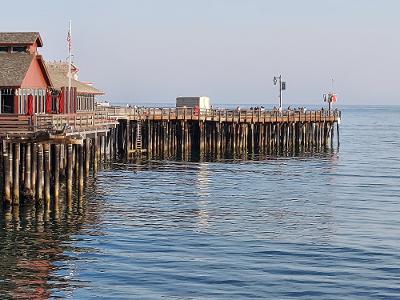
Stearns Wharf (Photo: Bonnie Carroll)
Stearns Wharf, the oldest working wood wharf in California, was built in 1872 by John Peck Stearns to facilitate the transfer of cargo and people from ships to shore. In 1925, the State of California, conveyed the Tidelands and the Harbor area to the City to be held in trust for certain priority uses and purposes. In 1926, Max Fleschmann offered the City of Santa Barbara $200,000 toward the construction of a harbor if the City would match the amount. A detached breakwater was completed in 1928 with an extension to shore constructed in 1930. Sand accretion began immediately with Leadbetter Beach and the current harbor commercial areas being created within seven years after the breakwater as completed.Up until the 1870s, Santa Barbara was virtually cut off from the outside world by its natural barriers of the ocean and the mountains. In 1867, John Peck Stearns moved to Santa Barbara and opened a lumberyard at the foot of State Street. Mr. Stearns noted that the town needed a long wharf so that Ocean ships could tie up at low tide. In 1872, with the financial backing of Colonel William Welles Hollister, Stearns completed the Wharf and Santa Barbara’s isolation from the outside world was over.
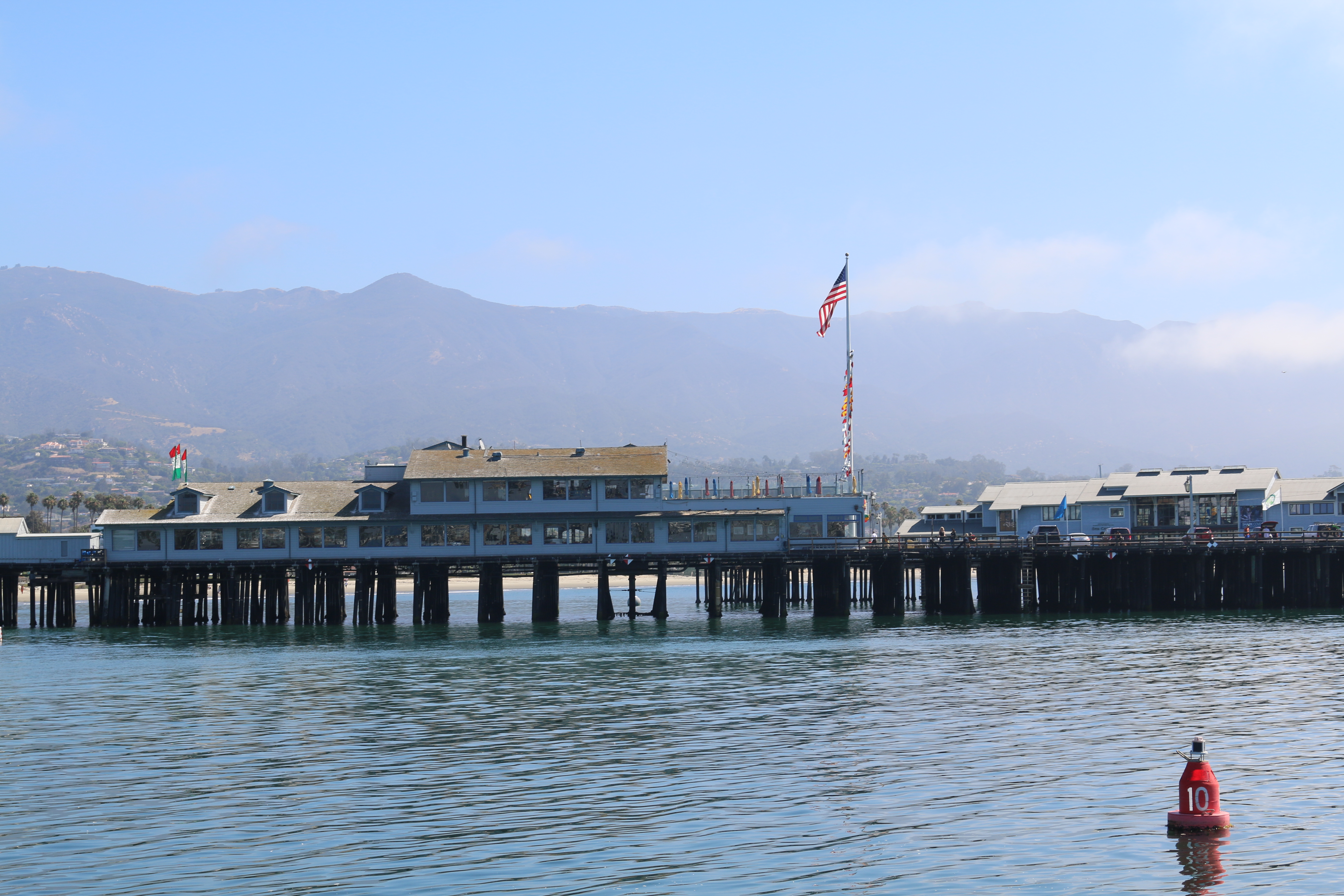
Sterns Wharf (Photo by Bonnie Carroll) The Wharf has endured since 1872, making it the oldest working wooden wharf in California. It is 2,300 feet long and has an area of 3.8 acres supported by 2,307 pilings. There are currently seventeen businesses on the Wharf including three restaurants, a shellfish market, a bait and tackle shop, tourist oriented shops, a Channels Islands exhibit hall and a marine museum. In 1878, A Chinese junk crashed into the Wharf during a severe storm, destroying 1,000 feet of decking. Before this damage could be repaired, the first tornado in the City’s history struck on New Year’s Eve, causing even more damage to the Wharf. In 1887, due to the heavy and regular tread of two hundred Civil War Veterans, the Wharf almost collapsed which would have thrown 3,000 people into the ocean. That same year marked the arrival of the railroad into Santa Barbara, signaling the decline of ship traffic. In response to the arrival of the railroad, J.P. Stearns built a 1,450 foot wye onto the Wharf to carry a railroad spur so that lumber could be quickly transferred from ships onto flat cars. The wye proved too expensive to maintain and was abandoned, after being battered by more than a decade of storms. A small portion of the wye remains today, housing the Sea Center marine museum and the Nature Conservancy exhibit hall. In 1921, the Wharf Narrowly escaped destruction by fire. The 600 room Potter Hotel burned down and a 50-mile-an hour gale sent sparks which ignited the pilings on the Wharf and palm trees along West Beach. In 1973, the famed Harbor Restaurant was destroyed by a spectacular pre-dawn fire, closing the Wharf. The Wharf was reopened eight years later. The Wharf was rebuilt with approximately the same building area that had existed previously and the same number of parking spaces. There had been other proposals for considerable increases in commercial space on the Wharf, but they have been denied by the Coastal Commission during the 1970’s. In February 1983, the Santa Barbara area was hit by a “100 year storm” which heavily damaged the Wharf and Harbor. Damage to the Wharf was estimated at over half a million dollars. In December 1987, another fierce storm struck and a derelict barge and fishing boat broke free from their moorings east of the Wharf and were hurled into the Wharf, along with their mooring balls. About 30 pilings were knocked out, causing the Wharf to sag near the beach and closing it for one week. Damages was estimated at $100,000 to the Wharf and several hundred thousands dollars in lost revenue to the Wharf merchants. In June 1986, a fire occurred on the shoreward finger of the Wharf. A fire caused by a damaged water pump caused heavy damage to the recently opened Sea Center as well as damaging the Wharf underpinnings and the Nature Conservancy building. The two grey whale models exhibited in the Sea Center building were not damaged but the shoreward finger of the Wharf was closed for six months for repairs…. Santa Barbara’s Historic Stearns Wharf Reopens Following Tragic Fire; 80% of Beachfront Landmark Saved and Open for BusinessSanta Barbara, California, November 23, 1998, A fire erupted in the vicinity of Moby Dick’s restaurant on Stearns Wharf Wednesday night, November 18, about 9:40 p.m. after the restaurant was closed for the evening. Fueled by the creosote preserved timbers of the wharf structure, the fire spread quickly. It consumed 420 feet of an outer segment of the 2,300 foot long wharf before being brought under control at 6:45 a.m., Thursday morning. Three businesses were totally destroyed by the fire: Moby Dick’s Restaurant, Mike’s Bait and Tackle Shop, and Santa Barbara Shellfish Company. 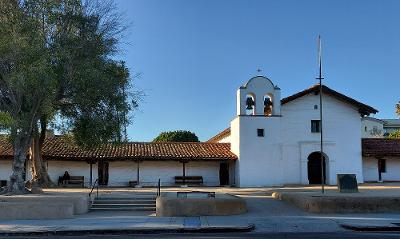
El Presidio de Santa Barbara (photo: Bonnie Carroll)
Another favorite of mine is El Precidio, an historic jewel located in the business center of the City of Santa Barbara Surrounded by the bustle of the modern-day city of Santa Barbara, El Presidio de Santa Bárbara State Historic Park preserves the site of the last of four military outposts built by the Spanish along the coast of Alta California. Two buildings of the original presidio have been restored, others have been reconstructed and archaeological excavations and additional reconstructions are continuing.
The Santa Barbara Presidio was founded on April 21, 1782, while the American Revolutionary War raged across the continent. Spain had earlier built three other presidios at San Diego, San Francisco and Monterey.
The presidios played a vital role in Spain’s occupation of Alta California. They protected the missions and settlers against attack, provided a seat of government, and guarded the country against foreign invasion. The Santa Barbara Presidio was both military headquarters and governmental center of the entire region extending from the southern limits of present day San Luis Obispo County to and including the Pueblo of Los Angeles.
Local Chumash Indians working under the supervision of Spanish soldiers erected the presidio’s buildings and walls using sun-dried adobe bricks laid upon foundations of sandstone boulders. Timbers from the nearby forests supported roofs of red clay tile and the finished walls were covered with whitewash.
The buildings of the Presidio were arranged in a quadrangle that enclosed a central parade ground, the Plaza de Armas. An outer defense wall with two cannon bastions surrounded the buildings. The most prominent structure was the Chapel with its imposing bell tower. This was the first church for the new town of Santa Barbara. 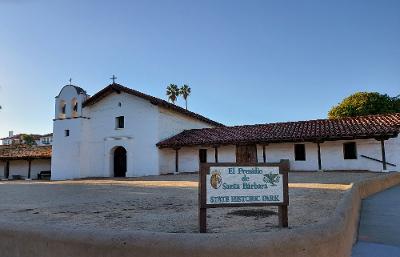
El Presidio de Santa Pueblo (Photo: Bonnie Carroll) The first Comandante of the new Presidio was Lt. José Francisco de Ortega. He was succeeded in 1784 by Lt. Felipe de Goicoechea, who supervised construction of the fortifications and living quarters for the soldiers and their families and remained in command until 1802.
One of the two remaining original sections of the Presidio is El Cuartel, the family residence of the soldier assigned to guard the western gate into the Plaza de Armas. This building is the oldest remaining in Santa Barbara and the second oldest in California. The second remaining original building is the Canedo Adobe, named after the Presidio soldier to whom it was deeded when the Presidio became inactive.
Also located within the boundaries of El Presidio de Santa Bárbara State Historic Park is the Buenaventura Pico Adobe, an example of a Mexican-period adobe built circa 1830. Santiago de la Cruz Pico had arrived in California with the 1776 Anza Expedition and Santiago's grandson Buenaventura and his wife Anita moved into the adobe after their marriage in 1850.
The most recent addition to El Presidio de Santa Bárbara State Historic Park is the Rochín Adobe, an example of an American-period adobe built in 1856 by José María Rochín. His wife, Lorenza Ordaz de Rochín, was a descendent of Francisco Ortega, the first Comandante of the presidio. The addition of the Rochín adobe to El Presidio de Santa Bárbara State Historic Park compliments the Spanish-period Presidio adobes (1780s) and the Mexican-period Buenaventura Pico adobe (circa 1830).
El Presidio de Santa Bárbara State Historic Park is operated by the Santa Barbara Trust for Historic Preservation under an operating agreement with California State Parks. The Santa Barbara Trust’s mission is to preserve, restore, reconstruct and interpret historic sites in Santa Barbara County. It engages in archaeological and historical research and publication to expand knowledge about Santa Barbara's history. The Santa Barbara Trust works closely with California State Parks, the City of Santa Barbara, the County of Santa Barbara and various cultural and educational constituencies to attract and inform a broad audience through its restoration projects, exhibits, living history demonstrations, public events and lectures, and public school programs. For more information about the Santa Barbara Trust for Historic Preservation, visit its website at http://www.sbthp.org. 
Butterfly Beach (photo: Bonnie Carroll) Although there are many awe inspiring beaches along the central coast my favorite is Butterfly Beach, located across the street from the Four Seasons The Biltmore Resort in Montecito.This beach features the Coral Casino Beach and Cabana Club and provides a beautiful backdrop for the world renowned Butterfly Beach.
The Coral Casino Beach and Cabana Club is a private membership club, situated atop Butterfly Beach at Four Seasons Resort The Biltmore Santa Barbara. Built in 1937, this legendary establishment and historic landmark has a rich history steeped in the glory of Hollywood, celebrated architecture and fine hoteliers.
In the fall of 1936, the Biltmore Hotel’s owner, Robert Stewart Odell, put into motion plans for a grand, first-class social club where prominent families of the area, and Hollywood’s elite could gather. Odell commissioned San Francisco architect Gardner A. Dailey – already well known for his contemporary style – to design the original “Biltmore Beach Club” on the triangular-shaped grounds adjacent to the hotel. Its look was in contrast to the Spanish-Colonial architecture of Santa Barbara, instead featuring clean, modern lines and Scandinavian contemporary furnishings. 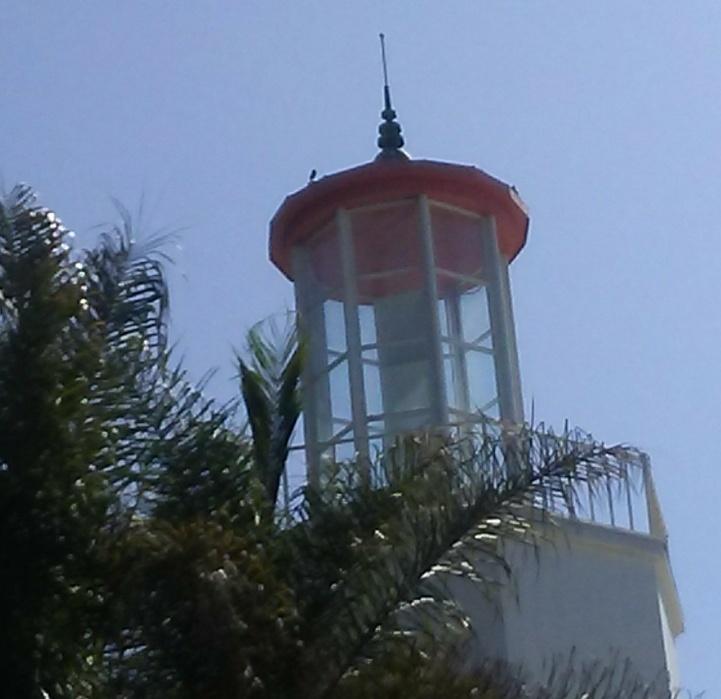
Coral Beach Casino Tower (Photo: Bonnie Carroll)
The curious name “Coral Casino” was inspired in part by its unique oceanfront setting; while “casino” was a term widely used in the era that defined the establishment’s social club status. The club’s most celebrated feature is a larger-than-Olympic size swimming pool (50 meters + 1 foot), which earned its irregular size during an evening of gentlemen’s poker. It is said that an argument transpired between Mr. Odell and the Olympic Commissioner of the time that resulted in the pool’s size being slightly increased so that it could never be used to host regulated events.
Since its grand opening on July 24, 1937, the Coral Casino has hosted some of the world’s foremost dignitaries, Hollywood stars and filmmakers, musicians and noted philanthropists. In 2005, current owner Ty Warner closed the club to begin an extensive, $65 million rehabilitation effort. Warner hired New York based architect and designer Peter Marino to lead the project – no easy task, given the building’s status as a designated historical landmark. Marino’s team meticulously restored the club to its original splendor, along with notable improvements that include upgraded locker facilities, fossilized marble decking, and a new second-story restaurant with panoramic ocean views. Marino looked to the vision and principles of Gardner Dailey for guidance in restoring the original theme and purpose of the club while embracing the Coral Casino’s most beloved feature—its spectacular setting on one of the most beautiful beaches in California.
In the summer of 2008, 71 years after its original début, the Coral Casino Beach and Cabana Club re-opened its illustrious glass double doors to reveal a brilliant world-class club, complete with all of the comfort, elegance and restrained glamour of the original design, once again welcoming back members and guests of Four Seasons Resort The Biltmore. Today, the Coral Casino celebrates a rich history as a family club, frequented by many members and guests who have been regular visitors since as early as the 1940s. It continues its unique social character, combining dining, fitness, and beachfront relaxation and fun, complete with an oceanfront ballroom for grand events, enhanced by world-renowned Four Seasons service and amenities. It's good to keep moving to stay healthy, and walking is a best bet. I've found places in my home town I enjoy walking and hope you will find some favorite destinations and do the same.
___________________________________________________________________ 
February is Heart Month. February 1st is National Wear Red Day. Go Red For Women in February so wear your red in support of Women's Heart Health. See helpful information here: https://www.nhlbi.nih.gov/.../education-and.../heart-month. American Heart Association _____________________________________________________________________ The Finest in Independent Living  Without the hassles of mundane chores, you’re free to enjoy the things you really want to do. At Vista del Monte, you’ll have time to engage in what’s most meaningful to you: pick up a new skill or hobby, travel, discover an interesting sport, or make more time to socialize. Whatever it is, we can help. With our Independent Living services, we take care of all the practical tasks, including transportation, housekeeping, and maintenance. Our culinary staff prepares delicious meals, handles all the day-to-day chores, and your wellbeing needs are attended to—all in one place. For information visit: www.vistadelmonte.org. Vista Del Monte – Santa Barbara, California – 805-687-0793 Without the hassles of mundane chores, you’re free to enjoy the things you really want to do. At Vista del Monte, you’ll have time to engage in what’s most meaningful to you: pick up a new skill or hobby, travel, discover an interesting sport, or make more time to socialize. Whatever it is, we can help. With our Independent Living services, we take care of all the practical tasks, including transportation, housekeeping, and maintenance. Our culinary staff prepares delicious meals, handles all the day-to-day chores, and your wellbeing needs are attended to—all in one place. For information visit: www.vistadelmonte.org. Vista Del Monte – Santa Barbara, California – 805-687-0793

|





